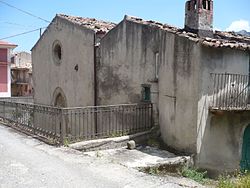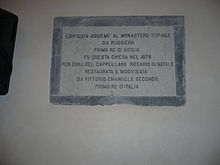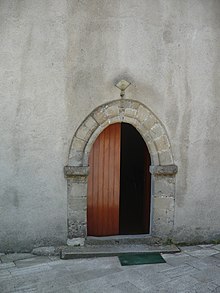Novara di Sicilia monastery
| Novara di Sicilia Cistercian Abbey | |
|---|---|
 Badiavecchia from the southwest |
|
| location |
Region of Sicily Province of Messina |
| Coordinates: | 38 ° 0 ′ 51 " N , 15 ° 7 ′ 53" E |
| Serial number according to Janauschek |
414 |
| Patronage | St. Mary |
| founding year | 1167 |
| Year of dissolution / annulment |
1784 |
| Mother monastery | Sambucina Monastery |
| Primary Abbey | Clairvaux Monastery |
|
Daughter monasteries |
Santa Maria di Roccamadore |
The Novara di Sicilia monastery (also Santa Maria di Vallebona; Nuara) is a former Cistercian abbey in Sicily and perhaps the first monastery of the order on the island. It was in the municipality of Novara di Sicilia in the province of Messina . It was initially built around 5 km from the center in the Badiavecchia district, but was later moved to the center.
history
The founding of the monastery in 1137, which is occasionally claimed in literature and also on the commemorative plaque from the 19th century in the old abbey church, is probably not true. The support by Queen Margarita and King Tankred is documented . The monastery does not appear in the records of the Cistercian order until 1172. Sambucina Monastery is considered the mother monastery . Thus Novara belonged to the filiation of the Clairvaux Primary Abbey . The first abbot, Hugo (Ugo), is said to have been a pupil of Bernhard von Clairvaux . The monastery of Santa Maria di Roccamadore was founded from Novara and probably also the monastery of Santa Maria di Spanò . After an earthquake, the monastery is said to have been moved closer to the place in 1222. In 1444 a monk from Novara di Sicilia was appointed abbot of the Benedictine monastery of Santa Maria di Maniace, which Pope Boniface VIII had united with the monastery of Marmosoglio in 1296 , but the union failed due to resistance from the monastery of Maniace. In 1659 another relocation took place in the town center. The Cistercians withdrew from Novara in 1784 to the daughter monastery of Roccamadore. After the last Commendatarabb had sold the plant, it fell into disrepair. An attempt in 1904 to set up a Salesian Institute on the site of the monastery failed. Later a church orphanage was built.
Plant and buildings
From the old abbey in Badiavecchia, the single-nave abbey church has been preserved, which was renovated in the second half of the 19th century and was probably reoriented to the west on this occasion. The foundations of a semicircular apse can still be seen in the east of the church. The church has a walled-up west portal and two ogival portals in the north. The buildings immediately south of the church could go back to the original enclosure. The new monastery church has been preserved.
literature
- Balduino Gustavo Bedini: Breve prospetto delle Abazie Cistercensi d'Italia. Dalla fondazione di Citeaux (1098) alla metà del secolo decimoquarto. sn, sl 1964, pp. 67-68.


